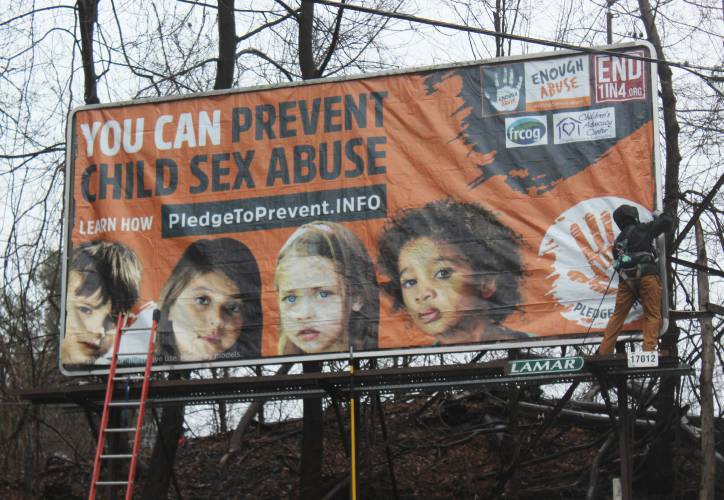Part 4: Enough Abuse shares series of tips for National Child Abuse Prevention Month

A billboard regarding child sexual abuse prevention is installed at the corner of Mill Street, Deerfield Street and Bank Row in Greenfield earlier this month. STAFF PHOTO/DOMENIC POLI
| Published: 04-25-2025 1:07 PM |
As part of National Child Abuse Prevention Month, the Greenfield Recorder is working with Enough Abuse, a citizen education and community engagement initiative organized in 2002 to prevent child sexual abuse in Massachusetts, to share a total of 20 tips for parents that will help them keep their children safe from sexual abuse. This is the final week and what follows are the final five tips.
Enough Abuse offers a one-hour training, “Enough! Preventing Child Sexual Abuse in My School,” which was selected by the U.S. Department of Justice for inclusion in its national repository of crime prevention programs. A peer-reviewed study published in the Journal of Child Sexual Abuse in 2019 showed, as a result of the course, increases in learner knowledge about child sexual abuse, ability to identify boundary-violating behaviors early, and willingness/confidence in reporting disclosed or suspected cases.
The training conveys information through two teacher avatars who encounter realistic situations of sexual misconduct by coworkers against students. To reinforce knowledge gains and support ongoing learning, a Resource Bank is included with downloadable booklets, handouts, videos, etc. Policy resources are also included and serve as the basis for post-course follow-up discussions among school personnel and administrators.
“Enough!” is available to public and private schools on a per-learner cost of $20 (lower rates apply for larger schools/districts). School administrators are welcome to preview the course at no cost as they consider its adoption as a staff development tool. Email info@enoughabuse.org for more information.
“Enough! Preventing Child Sexual Abuse in My Youth Organization” is a training course developed to meet the specific needs of youth organizations, and to address the challenges they face in preventing sexual misconduct and abuse. The one-hour course provides learners with an interactive experience while increasing their knowledge about child sexual abuse, their ability to identify boundary-violating behaviors before they escalate to legally reportable sexual offenses, and their confidence in reporting sexual misconduct and suspected cases of child sexual abuse.
Interested organization leaders should contact info@enoughabuse.org for more information on the course.
Enough Abuse offers technical assistance and support to public and private schools that seek to strengthen their policies relating to staff conduct to prevent child sexual abuse and sexual misconduct.
Adopting a code of conduct that details healthy interactions between staff and children/teens, as well as those that undermine safety, is essential because it can:
Article continues after...
Yesterday's Most Read Articles
 Northfield man dies in Erving motorcycle crash; Bernardston man injured in Deerfield crash
Northfield man dies in Erving motorcycle crash; Bernardston man injured in Deerfield crash
 Garage, house sustain ‘major damage’ in Phillips Street blaze in Greenfield
Garage, house sustain ‘major damage’ in Phillips Street blaze in Greenfield
 Athol man to serve five to seven years on child abuse charges
Athol man to serve five to seven years on child abuse charges
 No injuries from school bus, recycling truck collision in Gill
No injuries from school bus, recycling truck collision in Gill
 Rafters rescued from Deerfield River in Charlemont
Rafters rescued from Deerfield River in Charlemont
 HS Roundup: Olivia Machon drives in winning run in extras to propel Frontier softball past Greenfield, 6-5
HS Roundup: Olivia Machon drives in winning run in extras to propel Frontier softball past Greenfield, 6-5
■Protect children from sexual misconduct/abuse and its impact on their physical and mental health, social/emotional learning and academic achievement;
■Protect employees, contractors and volunteers by increasing their self-awareness of, and ability to correct, behaviors that might violate safe boundaries;
■Protect the school, its staff and students from the trauma and legal liability that can result from incidents of sexual abuse.
It should be noted that there is wide variation in current codes of conduct adopted by schools as they relate to child sexual abuse. Some include sexual harassment policies but often only on adult harassment of other adults, rather than on adult harassment of children. Some schools may include a perfunctory reference to child sexual abuse, such as, “Staff will not engage in any sexually inappropriate behavior with students,” but fail to detail the boundary-violating behaviors that should be prohibited.
Enough Abuse’s Code of Conduct Guide is the result of the organization’s review of many school policies over several years. If you are interested in technical assistance from Enough Abuse to improve an employee handbook or code of conduct, email info@enoughabuse.org.
While criminal and fingerprint background checks are a necessary part of the due diligence schools and youth organizations must conduct before hiring prospective employees, they are insufficient to screen away those who may pose a sexual risk to children. National risk assessment experts indicate that more than 80% of those charged with sexually abusing children in schools had no prior criminal records. States are now moving to a standardized screening process to strengthen their interviewing and hiring practices to require applicants to provide information about any past or pending investigations or findings of sexual misconduct.
As part of its Safety S.T.A.R.S. program, Enough Abuse offers:
1. A Model Disclosure Release Form that can be included in the interview process with new applicants and can provide information about whether professional licensure was revoked or surrendered in response to an investigation about previous sexual misconduct.
2. A model video script that schools can use to produce their own video to share with employees during the interview process. This five-minute video emphasizes the school’s commitment to training their staff about child sexual abuse prevention and its no-tolerance policy for sexual misconduct or abuse by any employee.
3. A 20-minute video, “How to Screen for Sexual Abuse Risk in the Employee Interview,” featuring a mock interview that serves as a guide for employers on how to screen for sexual abuse risk when conducting an interview of prospective employees or volunteers.
4. A “Screening for Sexual Risk when Conducting an Interview of Prospective Employees” tool containing questions that employers can ask prospective employees as part of the interview process.
5. A “Fact Sheet on Screening for Safety” that summarizes how to screen school employees to prevent hiring those who might pose a sexual risk to children.
It is important to limit opportunities for sexual abuse to occur at the school or organization’s facilities. Overall, when looking to increase the safety of children and youth within a facility, you may want to consider ways to increase visibility and decrease isolation. To increase visibility, increase lighting in dark areas, install cameras or mirrors and install windows in classroom doors so that activities with children and youth are easily observed. When this investment is too high, a “no closed door” policy may be used for a similar effect. Landscaping is also recommended to ensure open visible spaces.
There are also ways to decrease isolation in your building and grounds, a key goal for safety. Areas that are not essential for use by youth should be locked and access denied to both participants and staff. This includes unused rooms, storage areas, closets, rooftops, HVAC closets, abandoned buildings, etc. If areas are used occasionally, then a strict policy of access should be established and maintained. In areas where there may be a conflict between decreasing isolation and providing adequate privacy (such as dressing, bathing and bathroom areas), a strict policy should be established that is age-appropriate to the participants. For example, no staff should enter a bathroom stall with an adolescent, but help may be needed by a 3-year-old.
Enough Abuse offers resources to help with securing physical spaces. Email info@enoughabuse.org to learn more.






 Nationwide, beekeepers report loss of 1.6M colonies in 10 months
Nationwide, beekeepers report loss of 1.6M colonies in 10 months Antique truck show celebrates 20th year in Deerfield on Sunday
Antique truck show celebrates 20th year in Deerfield on Sunday Petting zoo brings joy to families in Orange
Petting zoo brings joy to families in Orange
